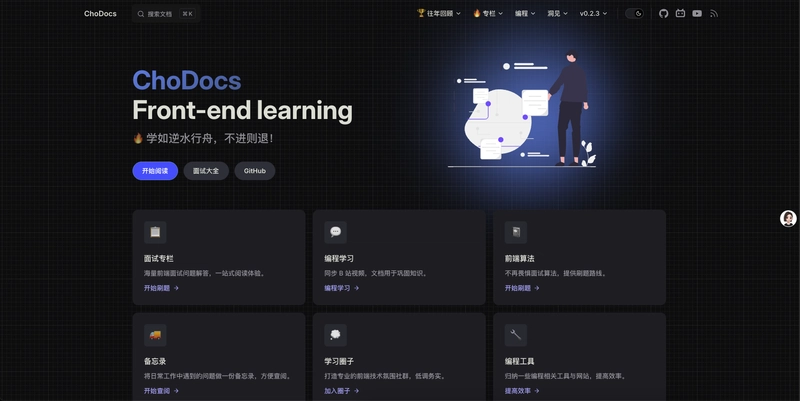A Developer's Guide to Defining and Using Types in Vanilla JavaScript for Better IDE IntelliSense
JavaScript's dynamic typing is a double-edged sword. While it offers flexibility, it can make code harder to maintain and understand as projects grow. Fortunately, you can harness the power of JSDoc comments to add type information to your vanilla JavaScript code, enabling rich IntelliSense features in modern IDEs without adopting TypeScript. This guide will walk you through practical techniques for defining and using types in vanilla JavaScript, helping both beginners and experienced developers write more robust code with excellent IDE support. Why Add Types to Vanilla JavaScript? Before diving into implementation, let's understand the benefits: Better IDE IntelliSense: Get auto-completion, parameter info, and quick documentation Error Detection: Catch type-related bugs before runtime Self-Documenting Code: Make your codebase more understandable Gradual Adoption: Add typing incrementally without converting to TypeScript No Build Step: Unlike TypeScript, JSDoc types work without compilation Getting Started with JSDoc Type Annotations Basic Variable and Function Types Let's start with simple type annotations: /** @type {string} */ const username = 'dev_enthusiast'; /** @type {number} */ const age = 30; /** * Greets a user * @param {string} name - The user's name * @returns {string} A greeting message */ function greetUser(name) { return `Hello, ${name}!`; } With these annotations, your IDE will now provide autocomplete suggestions specific to strings when you use the username variable and show an error if you try to assign a non-string value to it. Object Types with Properties For objects with specific properties: /** * @typedef {Object} User * @property {string} id - Unique identifier * @property {string} name - User's full name * @property {number} age - User's age * @property {boolean} isActive - Whether the user account is active */ /** * Creates a new user * @param {string} name - User's full name * @param {number} age - User's age * @returns {User} The created user object */ function createUser(name, age) { return { id: Date.now().toString(), name, age, isActive: true }; } // Using the type /** @type {User} */ const newUser = createUser('John Doe', 28); Now when you type newUser., your IDE will show all available properties with their types. Advanced Typing Techniques Union Types For variables that can have multiple types: /** * Function that works with various ID types * @param {string|number} id - User ID (can be string or number) * @returns {string} Formatted ID */ function formatId(id) { return `ID-${id}`; } // Both are valid formatId('abc123'); formatId(42); Array Types Define arrays with specific element types: /** @type {Array} */ const tags = ['javascript', 'webdev', 'tutorial']; /** @type {number[]} */ const scores = [98, 87, 92, 78]; /** * Calculates the average of an array of numbers * @param {number[]} values - Array of numeric values * @returns {number} The calculated average */ function calculateAverage(values) { return values.reduce((sum, val) => sum + val, 0) / values.length; } Function Types Define function signatures: /** * @typedef {(a: number, b: number) => number} MathOperation */ /** @type {MathOperation} */ const add = (a, b) => a + b; /** @type {MathOperation} */ const multiply = (a, b) => a * b; /** * Applies a math operation to two numbers * @param {number} a - First number * @param {number} b - Second number * @param {MathOperation} operation - Function to apply * @returns {number} Result of the operation */ function applyOperation(a, b, operation) { return operation(a, b); } console.log(applyOperation(5, 3, add)); // 8 console.log(applyOperation(5, 3, multiply)); // 15 Practical Examples for Real-World Applications Example 1: Data Fetching with Type Safety /** * @typedef {Object} ApiResponse * @property {boolean} success - Whether the request was successful * @property {string} message - Response message * @property {Array} data - Response data */ /** * Fetches data from an API endpoint * @param {string} url - API endpoint URL * @param {Object} [options] - Fetch options * @returns {Promise} API response */ async function fetchData(url, options = {}) { try { const response = await fetch(url, options); const result = await response.json(); return { success: true, message: 'Data fetched successfully', data: result }; } catch (error) { return { success: false, message: error.message, data: [] }; } } // Usage async function loadUsers() { /** @type {ApiResponse} */ const response = await fetchData('https://api.example.com/users'); if (response.success) { // IDE knows that response.data is an array return response.data.map(user => user.name); } else {

JavaScript's dynamic typing is a double-edged sword. While it offers flexibility, it can make code harder to maintain and understand as projects grow. Fortunately, you can harness the power of JSDoc comments to add type information to your vanilla JavaScript code, enabling rich IntelliSense features in modern IDEs without adopting TypeScript.
This guide will walk you through practical techniques for defining and using types in vanilla JavaScript, helping both beginners and experienced developers write more robust code with excellent IDE support.
Why Add Types to Vanilla JavaScript?
Before diving into implementation, let's understand the benefits:
- Better IDE IntelliSense: Get auto-completion, parameter info, and quick documentation
- Error Detection: Catch type-related bugs before runtime
- Self-Documenting Code: Make your codebase more understandable
- Gradual Adoption: Add typing incrementally without converting to TypeScript
- No Build Step: Unlike TypeScript, JSDoc types work without compilation
Getting Started with JSDoc Type Annotations
Basic Variable and Function Types
Let's start with simple type annotations:
/** @type {string} */
const username = 'dev_enthusiast';
/** @type {number} */
const age = 30;
/**
* Greets a user
* @param {string} name - The user's name
* @returns {string} A greeting message
*/
function greetUser(name) {
return `Hello, ${name}!`;
}
With these annotations, your IDE will now provide autocomplete suggestions specific to strings when you use the username variable and show an error if you try to assign a non-string value to it.
Object Types with Properties
For objects with specific properties:
/**
* @typedef {Object} User
* @property {string} id - Unique identifier
* @property {string} name - User's full name
* @property {number} age - User's age
* @property {boolean} isActive - Whether the user account is active
*/
/**
* Creates a new user
* @param {string} name - User's full name
* @param {number} age - User's age
* @returns {User} The created user object
*/
function createUser(name, age) {
return {
id: Date.now().toString(),
name,
age,
isActive: true
};
}
// Using the type
/** @type {User} */
const newUser = createUser('John Doe', 28);
Now when you type newUser., your IDE will show all available properties with their types.
Advanced Typing Techniques
Union Types
For variables that can have multiple types:
/**
* Function that works with various ID types
* @param {string|number} id - User ID (can be string or number)
* @returns {string} Formatted ID
*/
function formatId(id) {
return `ID-${id}`;
}
// Both are valid
formatId('abc123');
formatId(42);
Array Types
Define arrays with specific element types:
/** @type {Array} */
const tags = ['javascript', 'webdev', 'tutorial'];
/** @type {number[]} */
const scores = [98, 87, 92, 78];
/**
* Calculates the average of an array of numbers
* @param {number[]} values - Array of numeric values
* @returns {number} The calculated average
*/
function calculateAverage(values) {
return values.reduce((sum, val) => sum + val, 0) / values.length;
}
Function Types
Define function signatures:
/**
* @typedef {(a: number, b: number) => number} MathOperation
*/
/** @type {MathOperation} */
const add = (a, b) => a + b;
/** @type {MathOperation} */
const multiply = (a, b) => a * b;
/**
* Applies a math operation to two numbers
* @param {number} a - First number
* @param {number} b - Second number
* @param {MathOperation} operation - Function to apply
* @returns {number} Result of the operation
*/
function applyOperation(a, b, operation) {
return operation(a, b);
}
console.log(applyOperation(5, 3, add)); // 8
console.log(applyOperation(5, 3, multiply)); // 15
Practical Examples for Real-World Applications
Example 1: Data Fetching with Type Safety
/**
* @typedef {Object} ApiResponse
* @property {boolean} success - Whether the request was successful
* @property {string} message - Response message
* @property {Array
/**
* Fetches data from an API endpoint
* @param {string} url - API endpoint URL
* @param {Object} [options] - Fetch options
* @returns {Promise} API response
*/
async function fetchData(url, options = {}) {
try {
const response = await fetch(url, options);
const result = await response.json();
return {
success: true,
message: 'Data fetched successfully',
data: result
};
} catch (error) {
return {
success: false,
message: error.message,
data: []
};
}
}
// Usage
async function loadUsers() {
/** @type {ApiResponse} */
const response = await fetchData('https://api.example.com/users');
if (response.success) {
// IDE knows that response.data is an array
return response.data.map(user => user.name);
} else {
console.error(response.message);
return [];
}
}
Example 2: Event System with Type Definitions
/**
* @typedef {Object} EventConfig
* @property {string} name - Event name
* @property {boolean} [bubbles=false] - Whether the event bubbles
* @property {boolean} [cancelable=false] - Whether the event is cancelable
* @property {Object} [detail] - Additional event data
*/
/**
* Creates and dispatches a custom event
* @param {Element} element - Target element
* @param {EventConfig} config - Event configuration
* @returns {boolean} Whether the event was canceled
*/
function triggerEvent(element, config) {
const { name, bubbles = false, cancelable = false, detail = {} } = config;
const event = new CustomEvent(name, {
bubbles,
cancelable,
detail
});
return element.dispatchEvent(event);
}
// Usage
const button = document.querySelector('#submit-button');
triggerEvent(button, {
name: 'custom:click',
bubbles: true,
detail: { timestamp: Date.now() }
});
Type Checking and Validation
While JSDoc provides type hints for IDE assistance, it doesn't enforce types at runtime. For production code, consider adding basic validation:
/**
* @typedef {Object} ProductConfig
* @property {string} name - Product name
* @property {number} price - Product price
* @property {string[]} categories - Product categories
*/
/**
* Creates a new product
* @param {ProductConfig} config - Product configuration
* @returns {Object} The created product
* @throws {TypeError} If validation fails
*/
function createProduct(config) {
// Runtime validation
if (typeof config.name !== 'string') {
throw new TypeError('Product name must be a string');
}
if (typeof config.price !== 'number' || isNaN(config.price)) {
throw new TypeError('Product price must be a valid number');
}
if (!Array.isArray(config.categories)) {
throw new TypeError('Product categories must be an array');
}
return {
id: generateId(),
...config,
createdAt: new Date()
};
}
// Usage
try {
const product = createProduct({
name: 'Premium Widget',
price: 29.99,
categories: ['electronics', 'gadgets']
});
console.log(product);
} catch (error) {
console.error('Failed to create product:', error.message);
}
Setting Up Your IDE for Optimal Experience
VS Code Configuration
To get the most out of JSDoc type annotations in VS Code, ensure you have the following settings in your settings.json file:
{
"javascript.suggestionActions.enabled": true,
"javascript.validate.enable": true,
"editor.quickSuggestions": {
"comments": true
},
"js/ts.implicitProjectConfig.checkJs": true
}
You can also add a // @ts-check comment at the top of your JavaScript files to enable TypeScript's checking engine on your JS code.
Using jsconfig.json
Create a jsconfig.json file in your project root for better IDE integration:
{
"compilerOptions": {
"checkJs": true,
"resolveJsonModule": true,
"strictNullChecks": true,
"strictFunctionTypes": true
},
"exclude": ["node_modules", "dist"]
}
Best Practices for Team Adoption
- Start Small: Begin by adding types to new code or critical modules
- Document Type Definitions: Create a central file for shared types
- Use IDE Extensions: Tools like "JSDoc Generator" can help automate documentation
- Consistency: Establish team conventions for type annotations
- Consider Type Checking in CI: Add static analysis tools to your pipeline
When to Consider TypeScript Instead
While JSDoc types are powerful, there are cases where TypeScript might be a better choice:
- Large-scale applications with complex type relationships
- Projects with multiple developers who prefer explicit typing
- Codebases that require strict type enforcement
- When advanced TypeScript features like generics are heavily needed
Conclusion
Adding type annotations to vanilla JavaScript through JSDoc comments provides many of the benefits of TypeScript without requiring a build step or full language migration. This approach enables better IDE IntelliSense, makes your code more maintainable, and serves as excellent documentation.
Start small by adding types to your function parameters and return values, then gradually expand to more complex type definitions as your team becomes comfortable with the approach. You'll quickly see the benefits in development speed, code quality, and team collaboration.
What typing strategies have improved your JavaScript development experience? Share your thoughts and tips in the comments below!
Connect with Me
If you found this article insightful, follow me for more posts on software architecture, backend development, and modern web technologies.










































































































































































![[The AI Show Episode 142]: ChatGPT’s New Image Generator, Studio Ghibli Craze and Backlash, Gemini 2.5, OpenAI Academy, 4o Updates, Vibe Marketing & xAI Acquires X](https://www.marketingaiinstitute.com/hubfs/ep%20142%20cover.png)
















































































































































































































































.jpg?#)













































































































































![YouTube Announces New Creation Tools for Shorts [Video]](https://www.iclarified.com/images/news/96923/96923/96923-640.jpg)

![Apple Faces New Tariffs but Has Options to Soften the Blow [Kuo]](https://www.iclarified.com/images/news/96921/96921/96921-640.jpg)

































































































































